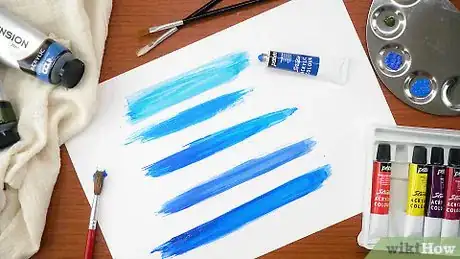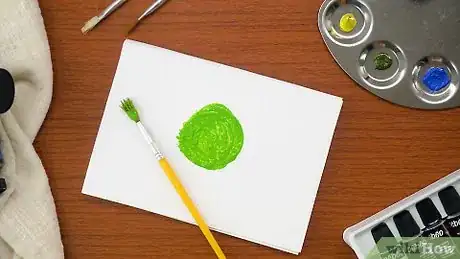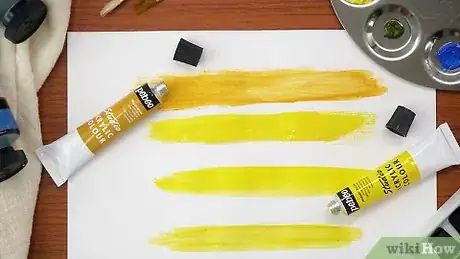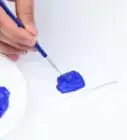This article was co-authored by wikiHow Staff. Our trained team of editors and researchers validate articles for accuracy and comprehensiveness. wikiHow's Content Management Team carefully monitors the work from our editorial staff to ensure that each article is backed by trusted research and meets our high quality standards.
There are 9 references cited in this article, which can be found at the bottom of the page.
The wikiHow Video Team also followed the article's instructions and verified that they work.
This article has been viewed 56,120 times.
Learn more...
If someone asked you to define the color teal, you’d likely describe it as a bluish greenish color, and you wouldn’t be wrong. But perhaps the version of teal in your mind’s eye is slightly lighter, brighter, or more vibrant than another’s. Experimenting with an array of acrylic colors allows you to mix and match, creating a broad spectrum of teals to satiate your palette and find your picture-perfect tone of teal. [1]
Steps
Choosing Your Colors
-
1Give yourself a selection of blues. Blue is one of the primary colors you will need to find your perfect teal, and artists may differ on what shade of blue with which to start. By grabbing a brighter, lighter shade of blue, along with a deeper, darker shade of blue (sometimes referred to as a “pthalo” blue), you will give yourself a better chance of creating a color that’s right for you.[2]
-
2Choose a vibrant green paint. Green is another essential color in making greenish-blue paint. You don’t want to go to dark, so choose a medium green shade of paint, akin to kelly green or emerald green.[3]
- Teal tends to be a darker shade than its close cousin, turquoise, but your blues can lend that element of depth and richness.[4]
Advertisement -
3Pick a couple of yellow paints. Again, artists differ on which shade of yellow to utilize in achieving their desired teal. A bright yellow will provide a greater brightness, while a more amber or burnt yellow will help to create a bolder, deeper hue.
-
4Grab a plain white paint for touching up your tones. Perhaps you’ve gone a bit darker than you intended, and need to lighten it up a bit. A dab of white paint can change the intensity of the color, and allow you to make smaller tweaks and adjustments.[5]
Mixing Your Paints
-
1Create a basic teal from which to work from. Mix 2 parts blue paint, with 1 part green, and ½ to 1 part yellow. You don’t need to nail it on the first go. Try to get a general feeling for the color and make alterations as necessary.[6]
- You can also create a basic teal by taking your pthalo blue paint, adding in some bright yellow, along with small amounts of white paint.[7]
- Brushes and palette knives can both be used to mix and paint. Brushes are good for mixing large amounts of paints, while a palette knife is a smaller and finer way of incorporating paints together. Choose one (or a series) that works best for you.[8]
- If you want to search through every tone and temperature of teal you can think of, you will need a large enough canvas to carry out the task. If a smaller sampling is all you desire, then a simple painter’s palette should do nicely.[9]
-
2Bolster colors by adding white. White isn’t just good for achieving a lighter shade; it also affects the opacity and complexity of colors. Squeeze some colored paint directly onto your canvas, and dab in some white to see how it can make your color really pop off the canvas.[10]
-
3Avoid adding black paint to your mixture. While adding black will certainly make your shade darker, it may also dull and dampen your desired look. Try adding a darker shade of one the colors you originally used to achieve a similar effect.[11]
wikiHow Video: How to Make Teal Paint
Things You’ll Need
- A brush or a palette knife
- A canvas or painter’s palette
References
- ↑ https://marketingaccesspass.com/what-colors-make-teal-how-to-make-teal/
- ↑ https://www.youtube.com/watch?v=vH8xAeu6njY&feature=youtu.be&t=2
- ↑ https://www.youtube.com/watch?v=AwkAHGRvEMU&feature=youtu.be&t=5
- ↑ https://www.differencebetween.com/difference-between-teal-and-turquoise/
- ↑ https://www.mybluprint.com/article/11-hacks-for-mixing-acrylic-paint-perfectly
- ↑ https://www.mybluprint.com/article/11-hacks-for-mixing-acrylic-paint-perfectly
- ↑ https://www.youtube.com/watch?v=vH8xAeu6njY&feature=youtu.be&t=29
- ↑ https://www.artistsnetwork.com/art-mediums/oil-painting/painting-knife-techniques/
- ↑ https://www.youtube.com/watch?v=vH8xAeu6njY&t=23
About This Article
If you don’t already have the perfect shade of teal in your collection of paints, you can make it by mixing blue, green, and yellow paint. Choose a lighter or darker shade of blue depending on how intense you want your teal to be, then select a vibrant shade of green, like Kelly or emerald. Finally, pick a shade of yellow to add a hint of brightness. If you want a more warm and intense shade of teal, go for a darker yellow, such as amber or burnt yellow. You can usually create a nice teal by mixing 2 parts blue paint, 1 part green, and 1 half to 1 part yellow. If you’re not satisfied with the result, play around with the proportions until you get the shade you want. Scroll down for tips on how to brighten up your teal with white paint!



















































